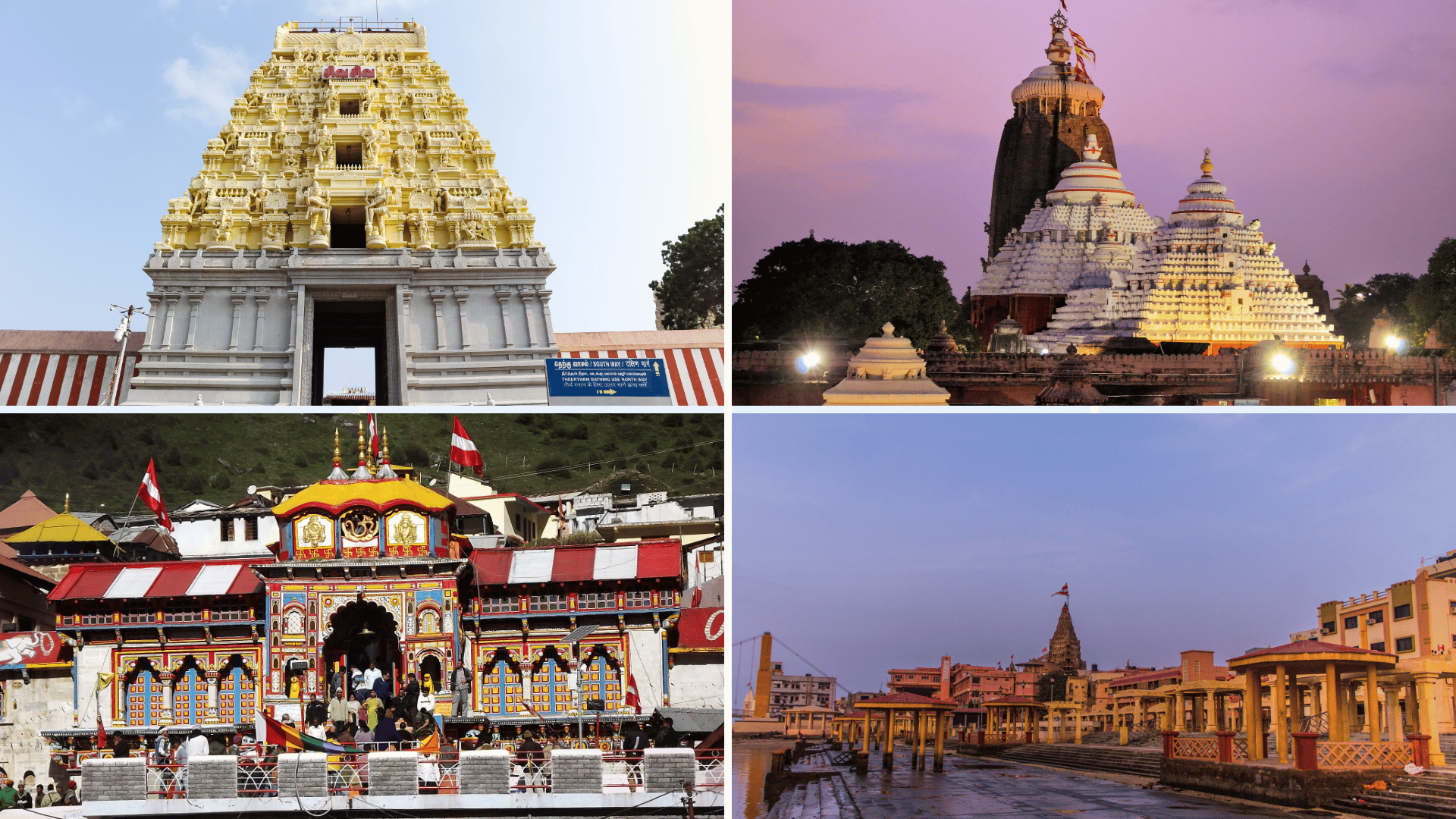The Char Dham, known as the “Four Abodes,” is a revered pilgrimage circuit in India, attracting spiritual seekers and travellers worldwide. This sacred journey includes four major sites: Rameshwaram, Dwarka, Jagannath Puri, and Badrinath. Each destination holds deep spiritual significance and showcases a rich cultural heritage, making Char Dham a must-visit for those seeking spiritual connection and cultural exploration in India. Let’s explore the unique features, historical backgrounds, and cultural significance that make Rameshwaram, Dwarka, Jagannath Puri, and Badrinath such remarkable stops on this iconic pilgrimage route.
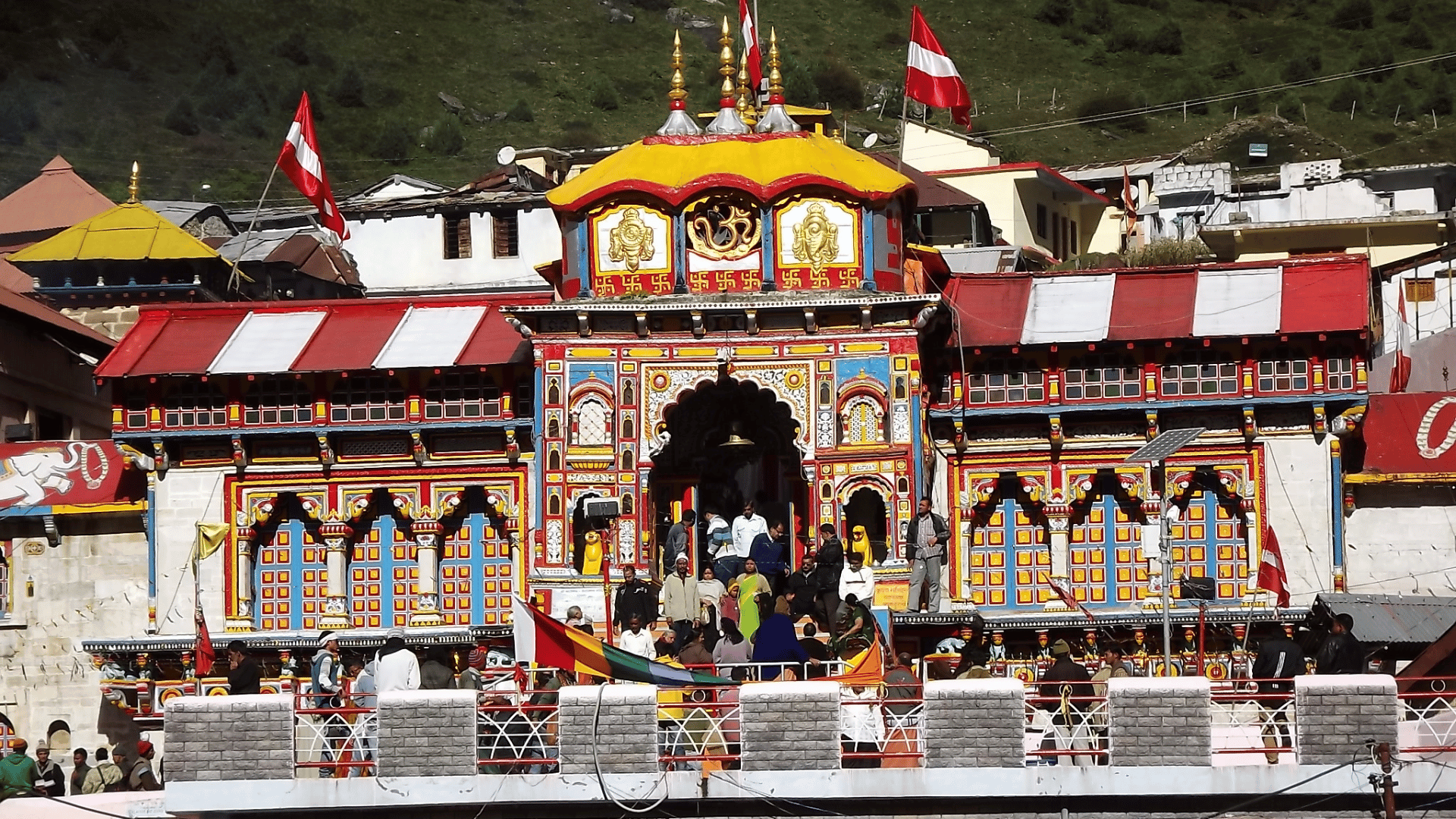
Nestled in the Garhwal Himalayas of Uttarakhand, Badrinath, one of the sacred Char Dham pilgrimage sites, stands at an impressive altitude of 3,300 meters along the scenic banks of the Alaknanda River. Enveloped by awe-inspiring snow-capped peaks and breathtaking natural beauty, this revered pilgrimage town is dedicated to Lord Vishnu, drawing thousands of devotees and nature enthusiasts each year.
Spiritual Importance
Badrinath, revered as a sacred seat of Lord Vishnu in his incarnation as Badrinarayan, holds a unique place in the spiritual landscape of India and is considered one of the most essential steps toward attaining moksha (liberation). Nestled within the Himalayan mountains, this holy town draws thousands of pilgrims each year who believe that visiting this ancient shrine purifies the soul and helps fulfil their highest spiritual yearnings.
Spiritual Significance
Badrinath holds a significant place as a key destination in both the Char Dham and Chota Char Dham pilgrimage circuits, attracting countless devotees every year. The Badrinath Temple, or Badrinarayan Temple, enshrines a black stone idol of Lord Vishnu, thought to have been established by the revered saint Adi Shankaracharya. According to legend, Lord Vishnu chose this serene spot to meditate under a Badri (berry) tree, which eventually gave the sacred site its name. This divine connection, combined with the temple’s historical and spiritual importance, makes Badrinath a cherished location for those seeking blessings, solace, and a deeper connection with their faith amidst the tranquil beauty of the Himalayas.
How to Reach:
Reaching Badrinath entails a scenic journey through the majestic mountains, which, while challenging, is immensely spiritually rewarding. Pilgrims can travel by road to Joshimath, situated approximately 45 kilometers from Badrinath. From Joshimath, they can continue their journey by bus or taxi, navigating through breathtaking landscapes that heighten the anticipation of reaching this sacred site. For those traveling by air, the nearest airport is Jolly Grant Airport in Dehradun, offering convenient access to the region. Additionally, the closest railway station is located in Rishikesh, providing further connectivity for pilgrims embarking on this spiritual adventure. The combination of stunning natural beauty and the promise of divine blessings makes the journey to Badrinath an unforgettable experience.
Best Time to Visit:
Due to heavy snowfall, the Badrinath Temple remains open only from May to November, making it an essential stop in the Char Dham pilgrimage circuit. The best time to visit Badrinath is during the summer months of May to June and after the monsoon season from September to October. During these periods, the weather is pleasant, providing ideal conditions for a spiritual pilgrimage. Pilgrims are encouraged to plan their visits during these optimal months to fully enjoy the serene beauty of the Himalayas while seeking divine blessings at this sacred site in the Char Dham.
Main Attractions
Badrinath Temple: Renowned for its stunning architecture, the Badrinath Temple stands as a vibrant tribute to Lord Badrinath, showcasing an array of intricate carvings and vivid colours that enhance its divine allure. The temple’s remarkable design features traditional Himalayan architectural elements, creating a harmonious blend of artistry and spirituality.
As one of the most revered sites in the Char Dham pilgrimage circuit, the serene atmosphere surrounding the temple invites both pilgrims and tourists alike. Visitors are captivated not only by the temple’s architectural beauty but also by the peaceful ambience that permeates the area. Whether seeking spiritual enlightenment or simply wishing to admire the craftsmanship, the Badrinath Temple is a must-visit destination that leaves a lasting impression on all who enter.
Tapt Kund: Discover the soothing warmth of Tapt Kund, a natural hot spring located near the Badrinath Temple, where visitors purify themselves before entering this sacred site. As an essential part of the Char Dham pilgrimage experience, Tapt Kund offers healing waters that blend spiritual ritual with relaxation, allowing pilgrims to wash away their worries and prepare for divine connection.
Neelkanth Peak: Rising majestically in the background, Neelkanth Peak enhances the picturesque landscape of Badrinath, offering breathtaking views that captivate all who visit. This magnificent mountain is not only a stunning visual spectacle but also a favorite destination for nature lovers and photographers alike.
Pilgrimage Rituals at Badrinath
Badrinath, a revered shrine dedicated to Lord Vishnu, serves as a central hub for significant pilgrimage rituals that attract thousands of devotees each year. These sacred practices play a vital role in the spiritual journey to this holy site. Here are the essential rituals that form the pilgrimage experience at Badrinath:
Bathing in Tapt Kund: Pilgrims begin their sacred journey to Badrinath by immersing themselves in Tapt Kund, a revered natural hot spring known for its healing properties. This ritual bathing is a significant part of the pilgrimage experience, as it is believed to cleanse both the body and spirit.
The warm waters of Tapt Kund, rich in minerals, provide a soothing and rejuvenating experience, symbolizing purification and readiness before entering the sacred temple. This act of bathing not only marks the physical preparation for the spiritual journey ahead but also fosters a sense of connection to the divine. As devotees emerge from the waters, they carry a renewed sense of purpose and devotion, ready to seek blessings at the temple of Lord Vishnu. The ritual of bathing in Tapt Kund serves as a powerful reminder of the importance of purification in the spiritual quest, making it an essential and cherished part of the char dham pilgrimage to Badrinath.
Darshan of Badrinarayan: At the heart of the Char Dham pilgrimage lies the profound experience of seeking darshan (viewing) of Lord Badrinarayan in Badrinath. Devotees engage in heartfelt prayers at the beautifully adorned idol, crafted from black stone, seeking blessings and divine guidance.
Offering of Prasad: Following the darshan of Lord Badrinarayan, pilgrims participate in the sacred tradition of offering prasad (blessed food) to the deity. This act of devotion is a significant ritual within the Char Dham pilgrimage, representing the deep connection established during the visit.
The prasad, prepared with love and devotion, is later taken home by devotees as a symbol of the blessings received. Sharing this sacred offering with family and friends reinforces the spiritual bond and serves as a reminder of the divine grace experienced at Badrinath. This ritual enriches the pilgrimage experience, highlighting the importance of community and faith in the journey through the Char Dham circuit.
Aarti Ceremony: In the evening, the aarti ceremony at Badrinath transforms the temple into a vibrant hub of devotion. As devotees gather, hymns are sung, and lamps are offered to Lord Badrinarayan, creating an atmosphere filled with spiritual energy and reverence.
This communal ritual fosters a strong sense of unity among the gathered pilgrims, allowing them to share in the collective experience of worship. The aarti not only enhances the spiritual ambience but also deepens the connection to the divine, making it a cherished highlight of the Char Dham pilgrimage. This powerful expression of devotion serves to inspire and uplift all who participate in this sacred tradition.
Performing Pujas: Many pilgrims at Badrinath engage in specific pujas to seek blessings for health, prosperity, and peace, connecting deeply with Lord Badrinarayan for guidance.
Nearby, Vyas Gufa, the legendary cave where Sage Vyasa is believed to have written the Mahabharata, offers a tranquil retreat for reflection and spiritual growth. Visiting this revered site adds a layer of wisdom and introspection to the Char Dham journey.
These sacred rituals and visits enrich the spiritual experience at Badrinath, affirming its role as a deeply significant pilgrimage destination within the Char Dham circuit.
Legends & Myths
Badrinath’s rich legends add profound allure to this sacred Char Dham site. One popular tale recounts how Lord Vishnu, after defeating the demon King Narakasura, sought refuge in the region and meditated under a grove of berry (badri) trees. To protect him, the goddess Lakshmi transformed into a berry tree, providing shade and giving the site its name, Badrinath.
Another well-known legend involves the sage Narada, who devoted himself to Lord Vishnu at this very place. In recognition of Narada’s unwavering devotion, Lord Vishnu appeared as Badrinarayan, leading to the establishment of the iconic Badrinath Temple, now a central destination for pilgrims.
The temple is also connected to the Mahabharata, as it’s believed the Pandavas visited Badrinath seeking redemption for their actions in the Kurukshetra war. These sacred myths enrich the spiritual journey of countless devotees who visit Badrinath each year.
Visiting Hours: 5:30 am – 9:00 pm
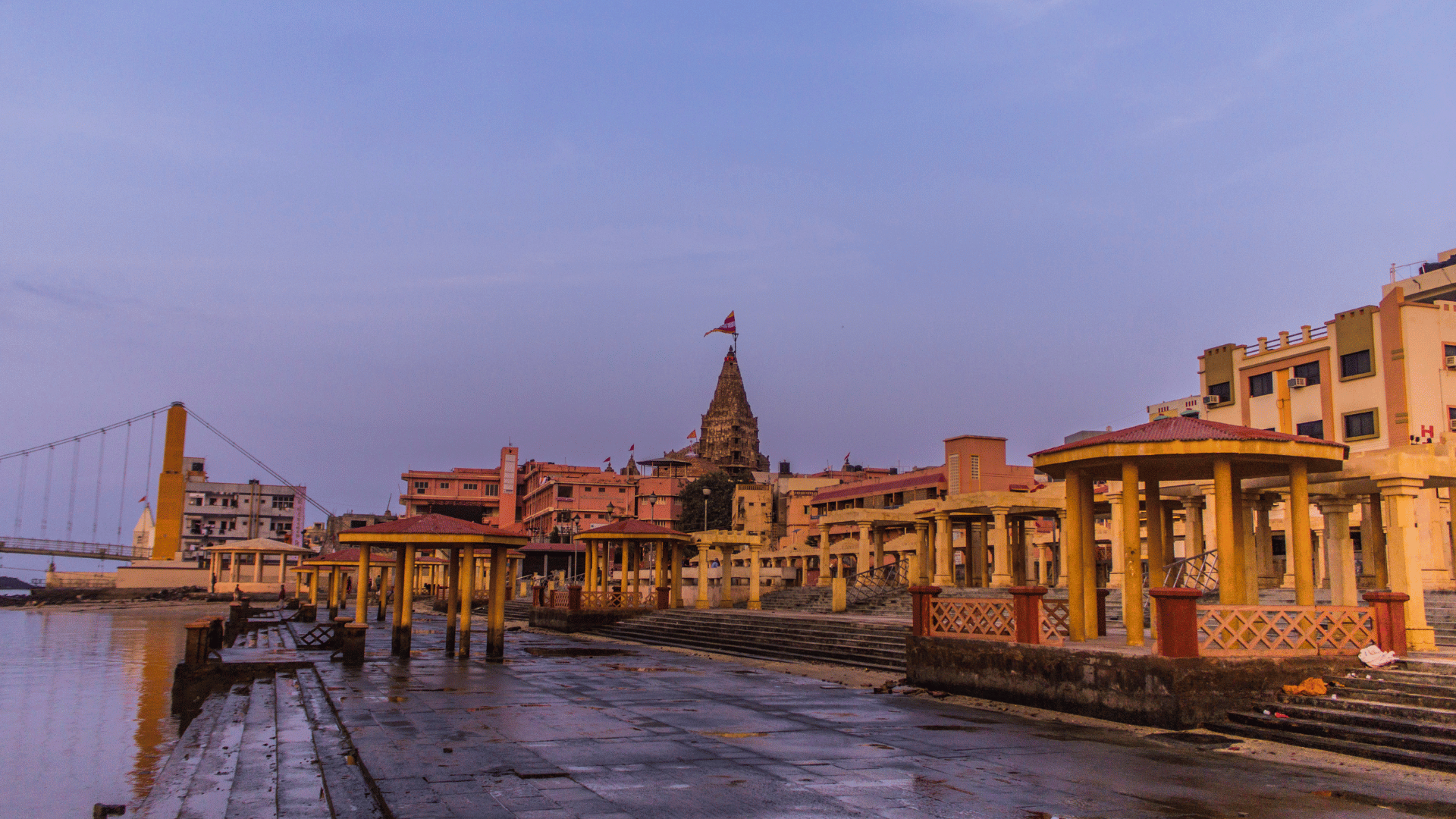
Situated in Gujarat, Dwarka holds immense religious importance, especially for followers of Lord Krishna. According to ancient lore, Lord Krishna established his kingdom here after leaving Mathura, transforming Dwarka into one of India’s most revered spiritual destinations. As part of the Char Dham pilgrimage circuit, Dwarka attracts countless devotees seeking to connect with its rich history, mythology, and divine significance associated with Lord Krishna.
Location and Accessibility
Dwarka Dham, located in the Devbhoomi Dwarka district of Gujarat, is well-connected and accessible for pilgrims and tourists alike. Travelers can reach Dwarka by road, rail, or air, making it a convenient destination within the Char Dham pilgrimage. The nearest airport is in Jamnagar, around 137 kilometres away, offering a practical route for those arriving by air. This accessibility enhances Dwarka’s appeal as a key spiritual destination, welcoming visitors from across India and beyond.
Historical and Cultural Significance
Dwarka, one of India’s oldest and most revered cities, is believed to have been founded by Lord Krishna. The iconic Dwarkadhish Temple built atop ancient ruins, carries a remarkable history of over 2,000 years. This temple holds immense religious and cultural importance in Hinduism, representing the legendary kingdom where Lord Krishna once resided. Its rich heritage and spiritual relevance make Dwarka a central site within the Char Dham pilgrimage, drawing devotees and history enthusiasts worldwide.
Spiritual Importance
The Dwarkadhish Temple, also known as Jagat Mandir, stands as a significant spiritual site dedicated to Lord Krishna, with a heritage spanning over 2,500 years. Famed for its stunning architecture, the temple features towering spires and houses the sacred Garbha Griha (sanctum sanctorum), where devotees gather to offer prayers.
Travel Information
Dwarka offers convenient access for pilgrims, with multiple transportation options ensuring a smooth journey. The nearest airport is in Jamnagar, approximately 137 kilometers away, providing an efficient travel option for visitors arriving by air. Additionally, Dwarka is well-connected by road and rail, making it easily accessible for those traveling from various parts of India. This connectivity enhances Dwarka’s appeal as a prime destination within the Char Dham circuit, allowing pilgrims to reach the revered site with ease.
Best Time to Visit
The optimal time to explore Dwarka is from October to March when the weather is comfortable and ideal for temple visits and sightseeing. This season enhances the experience of Dwarka’s spiritual and cultural sites, allowing pilgrims to enjoy the serene ambience of this Char Dham destination.
Main Attractions
Dwarkadhish Temple: This iconic temple, dedicated to Lord Krishna, stands out for its stunning architectural grandeur and profound spiritual significance. A must-visit for pilgrims, the Dwarkadhish Temple is the heart of Dwarka, drawing visitors from across the globe to witness its beauty and sanctity.
Bet Dwarka: This sacred island holds a deep connection to the life of Lord Krishna, making it a vital pilgrimage site. Known for its tranquil setting and religious significance, Bet Dwarka is a cherished destination for devotees seeking to experience the spiritual legacy of Krishna’s presence.
Rukmini Devi Temple: Dedicated to Rukmini, the beloved consort of Lord Krishna, this temple is a site of deep religious significance. Devotees visit to honor Rukmini’s devotion and seek blessings, adding a unique layer to the spiritual experience in Dwarka.
Legends and Myths
Dwarka is famously regarded as the mythical kingdom of Lord Krishna, believed to have submerged into the sea after he departed from this world. This legend adds a mystical allure to the city, which has reportedly been reconstructed multiple times over centuries, preserving its ancient spiritual heritage and significance.
Pilgrimage Rituals
Holy Dip in the Gomti River: Taking a dip in the sacred Gomti River is a revered ritual for pilgrims visiting Dwarka. This act of purification is believed to cleanse the soul, symbolizing spiritual renewal and devotion.
Offering Prayers at the Dwarkadhish Temple: A core part of the pilgrimage experience, offering prayers at this sacred temple allows devotees to deepen their spiritual connection and devotion to Lord Krishna.
Visit to Bet Dwarka: This sacred visit is a meaningful part of the pilgrimage, as Bet Dwarka holds a close connection to Lord Krishna’s life and legacy, offering devotees a profound and immersive spiritual experience.
Delve into the vibrant history and cultural heritage of Dwarka, one of the sacred Char Dham pilgrimage sites, where every corner tells a story of devotion, legends, and timeless significance.
Visiting Hours
Morning: 7:00 am – 12:30 pm
Evening: 5:00 pm – 9:00 pm
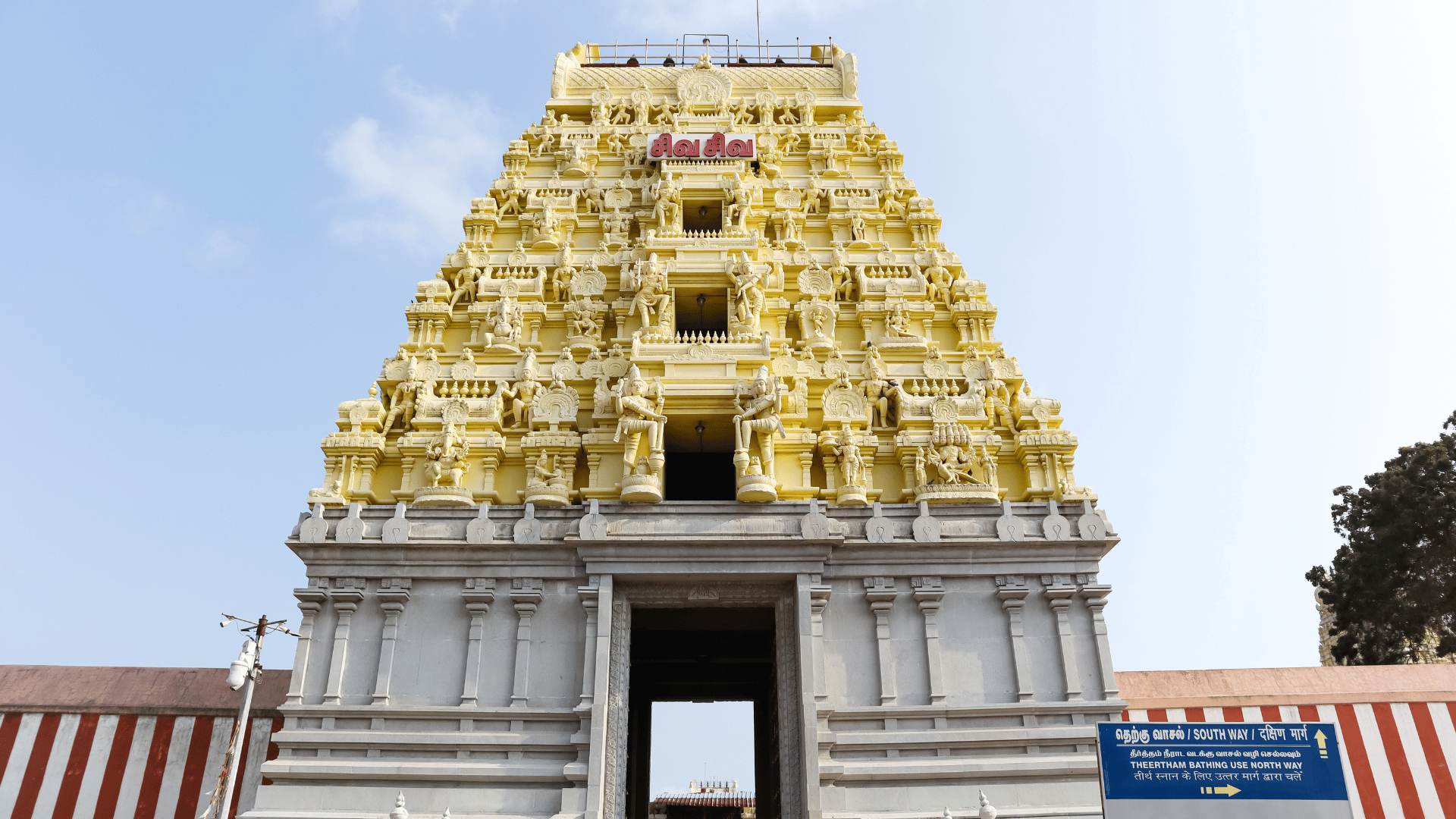
Location and Climate:
Rameshwaram, a renowned pilgrimage site, is located on Pamban Island in the Ramanathapuram district of Tamil Nadu, surrounded by the tranquil waters of the Gulf of Mannar. This sacred destination offers a peaceful atmosphere, perfect for spiritual reflection.
The region experiences a tropical climate, characterized by hot summers and moderate winters. The ideal time to visit Rameshwaram is from October to April, when the weather is pleasant for temple visits and sightseeing.
Rameshwaram is well-connected by road, rail, and air. The nearest airport is in Madurai, about 170 km away, ensuring convenient access for travelers. The town is also connected by a robust railway network, linking major cities across Tamil Nadu, making travel to this spiritual haven easy.
How to Reach
Rameshwaram is easily accessible by road, rail, and air. The nearest airport is in Madurai, approximately 170 km away. For rail travel, Rameshwaram is well-connected to major cities across Tamil Nadu and beyond, ensuring a smooth journey for pilgrims and tourists alike. These convenient transportation options make it hassle-free for visitors to reach this spiritual haven.
The Importance of Rameshwaram in Hinduism
Rameshwaram holds immense significance in Hinduism, primarily due to its association with the epic Ramayana. The Ramanathaswamy Temple, dedicated to Lord Shiva, is one of the twelve revered Jyotirlingas and an important pilgrimage site. Believed to have been constructed by the Pandya kings in the 12th century, the temple’s significance is intertwined with the story of Lord Rama, who is said to have worshipped Lord Shiva here before embarking on his journey to rescue his wife, Sita, from the demon king Ravana. According to the Ramayana, Lord Rama built a bridge from Rameshwaram to Lanka, making the city a pivotal location in Hindu mythology.
The temple is not only a major religious site but also a marvel of South Indian architecture, adorned with grand corridors and detailed carvings. Its status as one of the twelve Jyotirlingas further elevates its importance as one of the holiest Shiva shrines in India. Each year, millions of devotees visit Rameshwaram to seek blessings, immerse themselves in its spiritual atmosphere, and connect with its rich history and divine significance. The town’s spiritual allure, combined with its historical and cultural importance, makes Rameshwaram a must-visit destination for pilgrims from across the globe.
Spiritual Significance of the Ramanathaswamy Temple
According to legend, after his victory over the demon king Ravana, Lord Rama installed the Shiva Lingam at this sacred site to seek redemption and absolve himself of the sins he believed he incurred during the battle. This act of devotion is said to have been crucial in securing Lord Rama’s divine blessings, making the temple a deeply significant pilgrimage site for millions of devotees. The temple’s rich spiritual history and its association with the Ramayana further elevate its importance in the Hindu faith, solidifying its place as a spiritual beacon in Rameshwaram.
Ramanathaswamy Temple: This magnificent temple, dedicated to Lord Shiva, is renowned for its awe-inspiring architecture and profound religious significance. With its expansive corridors, intricately carved granite pillars, and towering spires, the temple is a masterpiece of South Indian temple design. As one of the twelve sacred Jyotirlingas, it holds immense spiritual importance, drawing thousands of devotees and visitors each year. The temple is not just a place of worship but a symbol of devotion, steeped in the rich history of the Ramayana and Lord Rama’s journey.
Dhanushkodi: Situated near Rameshwaram, Dhanushkodi is a historic coastal town steeped in mythology and natural beauty. According to Hindu legend, it is believed to be the starting point of the bridge (Rama Setu) that Lord Rama constructed to reach Lanka to rescue his wife, Sita. This town holds immense spiritual and historical significance, with its ruins serving as a reminder of the ancient bridge. Today, Dhanushkodi is known for its serene beaches, breathtaking views, and peaceful atmosphere, making it a popular spot for pilgrims and tourists alike. The site’s unspoiled beauty and connection to the Ramayana draw visitors seeking both spiritual solace and an escape into nature.
Agni Theertham: Agni Theertham is a sacred bathing spot located along the shores of Rameshwaram, holding great spiritual significance for pilgrims. It is believed that taking a dip in the holy waters of Agni Theertham purifies the soul and absolves one of sins, preparing devotees for their visit to the Ramanathaswamy Temple. According to legend, Lord Rama himself took a dip here to cleanse himself before worshipping Lord Shiva. This serene and peaceful spot, with its tranquil waters and spiritual atmosphere, remains an essential ritual for those undertaking the pilgrimage to Rameshwaram, symbolizing physical and spiritual cleansing before embarking on their temple journey.
Rameshwaram: Myths and Legends
Rameshwaram is deeply woven into the fabric of Hindu mythology, particularly through its connection to Lord Rama. As recounted in the Ramayana, it is believed that Lord Rama constructed the bridge, known as Rama Setu or Adam’s Bridge, to reach Lanka and rescue his wife, Sita, who had been abducted by the demon king Ravana. Before embarking on this monumental task, Lord Rama is said to have performed a prayer and puja at Rameshwaram, seeking Lord Shiva’s blessings for the success of his mission.
According to legend, Lord Rama, in order to seek absolution for any sins he may have committed during the war with Ravana, consecrated a sacred Shiva Lingam at this site. The Ramanathaswamy Temple, which houses this revered Jyotirlinga, stands as a testament to the divine intervention and spiritual significance of this place. This deep connection to Lord Rama’s quest for righteousness and his devotion to Lord Shiva makes Rameshwaram one of the most sacred pilgrimage destinations in India, attracting millions of devotees each year.
Pilgrimage Rituals in Rameshwaram
Ritual Bathing: A significant part of the pilgrimage to Rameshwaram involves bathing in the 22 sacred wells (Cheetham) within the temple complex. Each well is believed to possess unique spiritual properties, offering purification and blessings to pilgrims who immerse themselves in its waters. This ritual cleansing is seen as essential for spiritual rejuvenation and is a way for devotees to prepare themselves for the sacred prayers and rituals at the temple.
Prayers at the Jyotirlinga: Offering prayers at the Jyotirlinga within the Ramanathaswamy Temple is a central and revered part of the pilgrimage. The Jyotirlinga, believed to be consecrated by Lord Rama himself, represents the divine presence of Lord Shiva. Pilgrims gather at the temple to seek divine blessings, pray for forgiveness, and experience a deep spiritual connection with the divine. This prayer ritual is a vital component of the journey to Rameshwaram, helping devotees to immerse themselves in the sacred energy of the place.
How to reach
Rameshwaram, an enchanting island town in Tamil Nadu, is renowned for its ancient temples, breathtaking beaches, and vibrant cultural heritage. Whether you’re embarking on a spiritual journey or seeking a peaceful retreat, getting to Rameshwaram is straightforward. Here are your options:
By Air
Rameshwaram is served by Madurai Airport (IXM), located approximately 150 kilometres from the town. From Madurai, you can easily hire a taxi or take a bus to reach Rameshwaram. Another convenient option is Tuticorin Airport (TCR), situated around 120 kilometres away, which also provides good connectivity to the town, offering an alternative route for travellers. Both airports make it simple for visitors to access Rameshwaram and begin their spiritual journey.
By Train
Rameshwaram is well-connected by rail, with its own railway station offering excellent connectivity to major cities across Tamil Nadu and beyond. Regular trains from cities like Chennai, Madurai, and Coimbatore run frequently, providing travellers with a comfortable and scenic journey. The train ride to Rameshwaram is not only convenient but also allows passengers to enjoy the picturesque landscapes along the way.
By Bus
Rameshwaram is well-connected by an extensive network of state-run and private buses. Regular bus services operate from nearby cities such as Madurai, Kanyakumari, and Tirunelveli. This affordable mode of transportation allows travellers to enjoy the scenic beauty of Tamil Nadu, making the journey to this spiritual destination a delightful experience.
By Car
For those who prefer a road trip, Rameshwaram is easily accessible via well-maintained highways. The drive from Madurai, approximately 170 kilometers away, takes around 3-4 hours. The route offers scenic views, especially as you approach the coastal areas, adding to the charm of the journey.
Once in Rameshwaram, getting around is convenient with various local transport options, including auto-rickshaws, taxis, and bicycles available for hire. For a more immersive experience, walking is a great way to explore the town’s cultural heritage and enjoy its picturesque scenery at your own pace.
Visiting Hours
Morning: 5:00 am to 1:00 pm
Evening: 3:00 pm to 9:00 pm
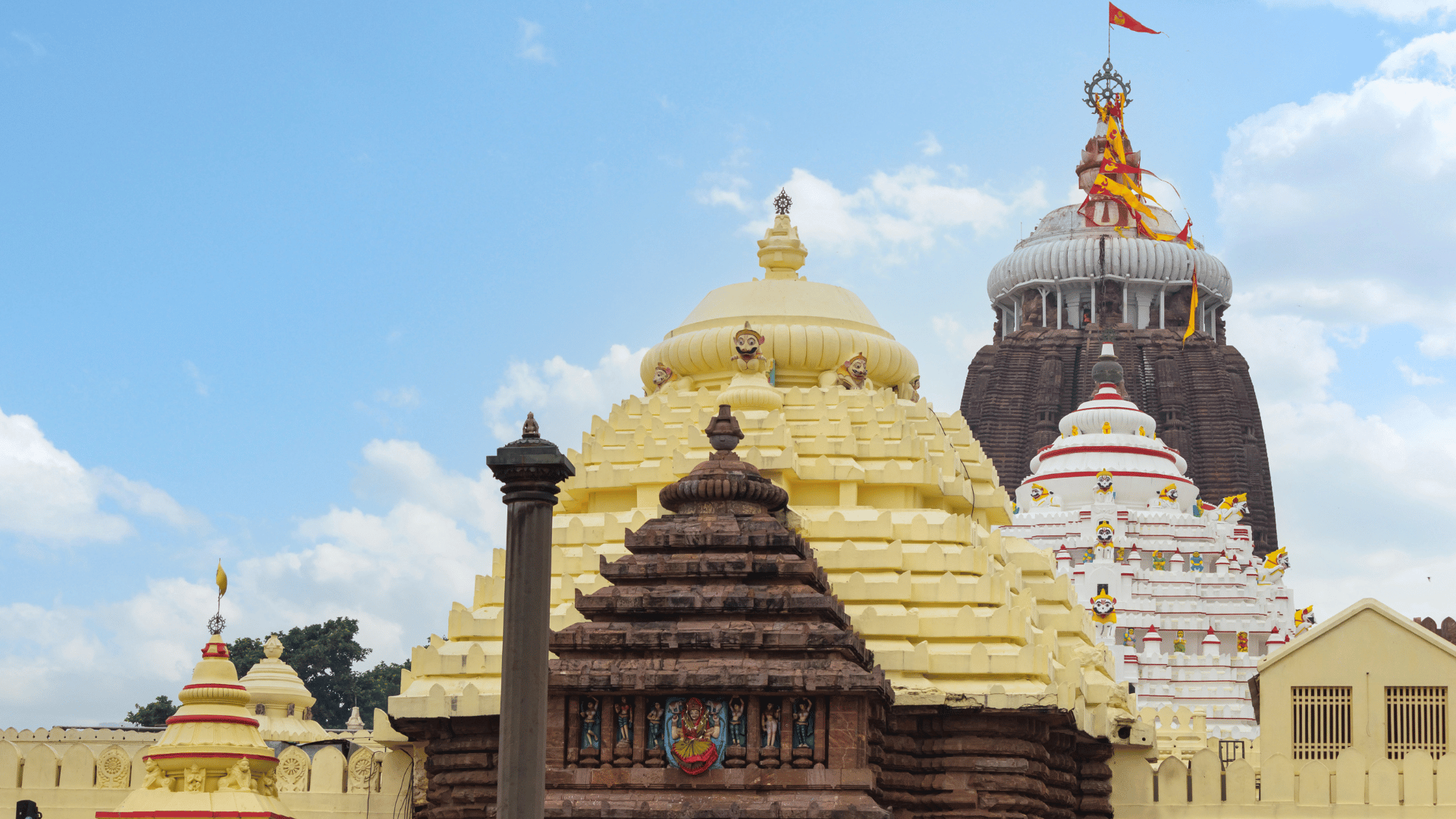
Nestled on the eastern coast of India in Odisha, Puri is renowned for its vibrant annual Rath Yatra (chariot festival) dedicated to Lord Jagannath, an incarnation of Lord Krishna. The Jagannath Temple, a magnificent example of Kalinga architecture, draws millions of devotees each year, making it one of the most important pilgrimage destinations in India.
How to reach
Puri is well-connected and can be reached by road, rail, and air. The nearest airport is Bhubaneswar, situated about 60 kilometres away, offering regular flights from major cities. The town is also accessible by train, with frequent services connecting it to various parts of India. Additionally, Puri is easily reachable by road, with buses and taxis available from nearby cities like Bhubaneswar and Cuttack.
History and Significance
The Jagannath Temple, built in the 12th century under the reign of King Anantavarman Chodaganga Deva, is a marvel of Kalinga architecture. It is not only a key spiritual landmark in Odisha but also one of the four sacred sites in the Chardham pilgrimage, elevating its status as a vital destination for devotees. The temple is dedicated to Lord Jagannath, an incarnation of Lord Krishna, and is especially renowned for its annual Rath Yatra (chariot festival), which attracts millions of pilgrims and tourists from around the world. The temple’s significance lies in its deep-rooted connection to Hindu spirituality and its role in the cultural heritage of India.
Key Highlights
Jagannath Temple: A revered pilgrimage destination, the Jagannath Temple is famous for its vibrant deities, adorned in colourful garments and intricate jewellery. The temple’s grand architecture and spiritual significance make it a focal point for devotees.
Gundicha Temple: Situated a few kilometres from the main temple, the Gundicha Temple is the temporary abode of Lord Jagannath during the Rath Yatra. It holds immense importance in the festival and offers a serene atmosphere for spiritual reflection.
Puri Beach: Famous for its scenic shoreline, Puri Beach not only offers breathtaking views but also reflects the town’s vibrant cultural heritage. Visitors can enjoy traditional dance performances, explore local handicrafts, and immerse themselves in the unique blend of nature and culture.
Legends and Myths
According to legend, Lord Jagannath, along with his siblings Balabhadra and Subhadra, resides in the Jagannath Temple. Every 12 years, the wooden idols of these deities are ceremonially replaced in a ritual known as Nabakalebara, symbolizing renewal, rejuvenation, and the continuity of devotion. This sacred practice is a significant event for devotees, marking a deep connection between tradition and spirituality.
Pilgrimage Rituals
Attending the Rath Yatra: The grand Rath Yatra is a highlight of Puri’s religious calendar, attracting pilgrims and visitors from all over the world. The procession of the chariots carrying Lord Jagannath, Balabhadra, and Subhadra through the streets of the town is a spectacular sight, filled with devotion and fervour.
Offering Prayers: Devotees visit the Jagannath Temple to participate in prayers and rituals, seeking divine blessings and spiritual upliftment. The temple is a sacred space for meditation and connection with the divine.
Participating in Maha Prasad: Pilgrims partake in Maha Prasad, the sacred communal meal offered at the temple, which is known for its spiritual significance. This blessed food, offered by Lord Jagannath himself, is not only a feast for the body but also for the soul, celebrated for both its taste and sacredness.
The third Step of the Temple
As you approach the Jagannath Temple, the path leads you to a revered series of twenty-two steps known as Baisi Pahacha. These steps are not just a physical ascent but a symbolic journey, representing various stages of life and spiritual growth. Each step signifies a progression toward enlightenment, leading devotees closer to a sacred experience. At the summit of these steps awaits the ultimate blessing—the darshan, or the sacred sight, of Lord Jagannath.
A unique feature of the temple’s entrance is the Yam Shila stone, located near the steps. It is believed that stepping on this stone while entering the temple cleanses one’s sins (paap), preparing the soul for the sacred darshan. However, tradition holds that stepping on it when leaving the temple diminishes the spiritual merits (punya) gained from the darshan. This dual nature of the Yam Shila adds to its spiritual significance, reminding devotees of the balance between purification and the protection of one’s spiritual gains.
Devotees generally step on the Yam Shila only upon entry, reflecting the belief that this action symbolizes purification and readiness to receive divine blessings. The stone serves as a reminder that one’s intentions and actions can influence their spiritual journey. By stepping on it at the entrance, pilgrims prepare themselves spiritually for the blessings of Lord Jagannath, while avoiding it on the way out helps preserve the spiritual merits earned during their visit char dham.
Visiting Hours: 5:30 AM – 9:00 PM


